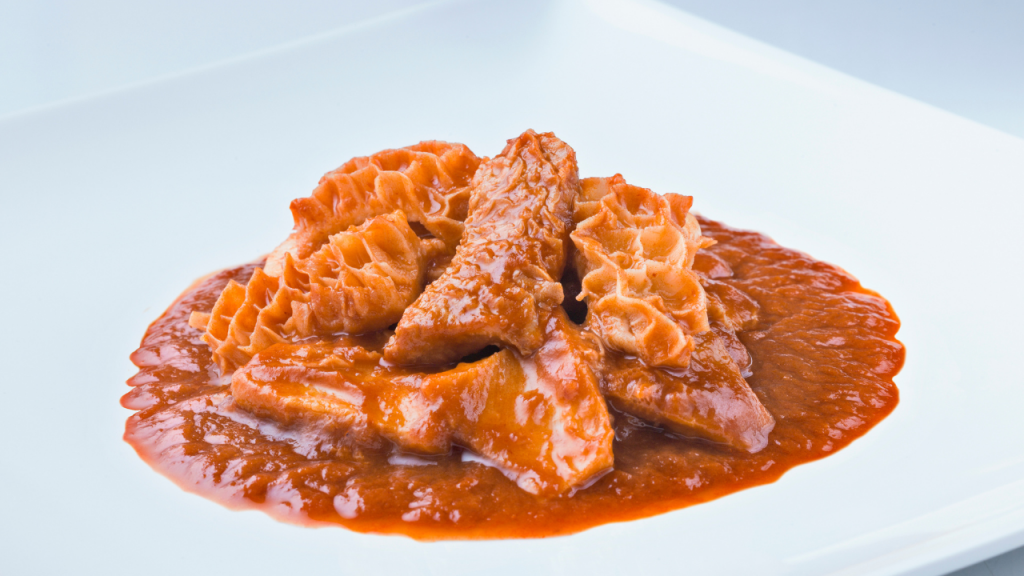Tripe, the edible lining from the stomachs of various animals, might not be the most conventional choice in many modern diets, but it has a long history of consumption in different cultures around the world. While its distinct texture and flavour might not be everyone’s cup of tea, tripe offers several potential health benefits that make it a noteworthy addition to a well-rounded diet.
But first, what is tripe?
Tripe is a type of organ meat made from the edible stomach lining of farm animals. Considered an edible byproduct of animal slaughter, tripe is sold for human consumption or added to animal foods, such as dry dog kibble. Tripe is a tough meat that needs to be prepared properly to become edible. It’s commonly cooked by moist heat methods, such as boiling or stewing. It has a chewy texture and a mild taste, taking on the flavor of other ingredients it’s cooked with.
Beef tripe is one of the most commonly eaten varieties but you may also consume pork tripe.
The benefits of eating tripe:
Rich source of protein
Tripe is an excellent source of high-quality protein. Protein is essential for various bodily functions, including tissue repair, muscle growth, and hormone production. Including tripe in your diet can help meet your protein needs and support overall health.
Amino acids
Tripe contains a variety of essential amino acids, which are the building blocks of proteins. These amino acids play crucial roles in maintaining healthy skin, hair, nails, and immune system function.
Vitamins and minerals
Tripe is a good source of several vitamins and minerals, including vitamin B12, zinc, selenium, and iron. Vitamin B12 is important for nerve function and red blood cell formation, while zinc and selenium contribute to immune system support and antioxidant defense. Iron is vital for oxygen transport in the body.
Collagen and connective tissue
Tripe is rich in collagen, a protein that supports skin elasticity, joint health, and overall connective tissue integrity. Consuming collagen-rich foods like tripe may contribute to healthier skin and improved joint function.
Digestive health
Tripe contains a unique type of fibre known as inulin, which can act as a prebiotic. Prebiotics promote the growth of beneficial gut bacteria, supporting digestive health and potentially improving nutrient absorption.
Low in fat
Tripe is generally low in fat, making it a suitable choice for those looking to manage their fat intake. It can be a lean protein option that provides essential nutrients without excessive calorie consumption.
Sustainable and affordable
Because tripe is not as desirable as steak and other meat products, it’s a more affordable protein option for those trying to save money. Consuming different parts of an animal, including less commonly used cuts like tripe, can contribute to reduced food waste and support sustainable practices within the food industry.
Adding tripe to your diet
Tripe Stir-Fry: Slice tripe into thin strips and stir-fry it with colourful vegetables, such as bell peppers, onions, and snap peas. Season with your favourite sauces and spices for a flavourful and nutritious meal.
Tripe Tacos: Create delicious tacos by cooking tripe until tender, then shredding it and filling soft or hard taco shells. Top with fresh salsa, chopped cilantro, and a squeeze of lime for a zesty and satisfying dish.
Tripe Soup: Add tripe to hearty soups, such as a comforting tripe and vegetable soup or a spicy tripe stew. Combine with broth, vegetables, and aromatic herbs for a nourishing and warming meal.
Tripe Curry: Incorporate tripe into a rich and aromatic curry. Simmer tripe with coconut milk, curry spices, and vegetables for a flavourful and exotic dish that pairs well with rice or bread.
Tripe Salad: Prepare a refreshing tripe salad by marinating cooked tripe with olive oil, lemon juice, herbs, and your choice of veggies like cherry tomatoes, cucumbers, and red onions. Serve chilled for a light and protein-packed meal.
It’s important to note that the benefits of eating tripe can vary depending on factors such as preparation methods, cooking techniques, and personal dietary preferences. While tripe offers several potential advantages, individuals with certain dietary restrictions, allergies, or sensitivities should exercise caution and consult with a healthcare professional before incorporating it into their diet.
ALSO SEE: Benefits of eating liver
Written by Maegan-Leigh Jacobs
Feature image: Pixabay

